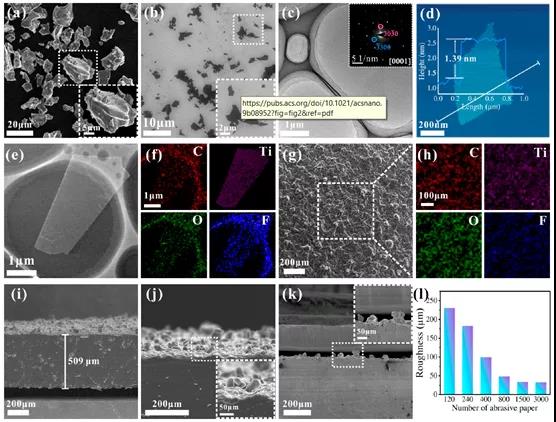ACS Nano: Biologically inspired MXene high performance spray piezoresistive sensor
QQ Academic Group: 1092348845
Detailed
¡¾Research Background¡¿
Wearable, flexible, and retractable electronic sensors have aroused great research interest because of their great potential in human activity monitoring, biomedical research, and artificial intelligence interaction. Real-time monitoring and information feedback of human activities, such as blood pressure, pulse, and limb movement, are of great significance in biomedical research, disease diagnosis, and timely treatment. At present, capacitive, piezoresistive, piezoresistive and friction pressure sensors have been reported as wearable functional electronic products. When pressure changes into resistance changes, piezoresistive sensors exhibit the advantages of extremely high sensitivity, fast signal response, low manufacturing cost, and reliable stability, making them ideal for next-generation sensors. Despite the great progress in the research of piezoresistive sensors, the low dosage of conductive layer materials and the large-scale preparation of low-cost, high-sensitivity piezoresistive sensors still face huge challenges.
The morphology and microstructure of the sensing material have been widely recognized as important factors to improve the sensitivity of the pressure sensor. However, due to the low signal response and the complicated process flow, it is still very difficult to make a high-sensitivity sensor, and the cost is relatively high. It needs more effort to pursue excellent conductivity, obvious switching ratio and simple process flow. As a skin for humans to detect changes in the external environment, it can provide a good inspiration for the preparation of the sensor.
¡¾Achievement Introduction¡¿
Recently, Professor Gao Yihua and Associate Professor Li Luying of Huazhong University of Science and Technology published an article in the internationally renowned academic journal ACS Nano titled: Bioinspired Microspines for a High-Performance Spray Ti 3 C 2 T x MXene-Based Piezoresistive Sensor . A simple sandpaper stencil printing process to produce a highly sensitive MXene-based piezoresistive sensor with randomly distributed spinous microstructures. Using thermal spraying method, a single layer of Ti 3 C 2 T x MXene nanosheets with high electrical conductivity was uniformly deposited on the microstructure PDMS by van der Waals force . As the pressure increases, the biologically-inspired micro spines can effectively increase the contact area of the conductive channel, thereby improving the sensing performance of the pressure sensor. Through in-situ scanning electron microscope (SEM) and finite element simulation, the changes of the conductive channel between the piezoresistive sensor and the interdigitated electrode are analyzed, and the working mechanism of the piezoresistive sensor is discussed. The resulting piezoresistive sensor has excellent sensitivity (151.4 kPa −1), Relatively short response time (<130ms), fine pressure detection limit (4.4 Pa) and good cycle stability of more than 10,000 times. In addition, the low material content, flexible substrate, and simple preparation process make the current sensor more suitable for large-scale preparation and application of electronic skin. The sensor is ultra-thin, flexible, and easy to attach to the skin, and has application potential in human activity recognition, pressure distribution arrays, and human-computer interaction. Based on the above excellent sensing performance, the MXenes bio-inspired micro-spine sensor is very suitable for human activity detection, medical monitoring, artificial intelligence equipment and other sensitive information collection.
¡¾Graphic introduction¡¿

Figure 1. Design and assembly of a bionic spinous microstructure piezoresistive sensor.

Figure 2. Characterization of MAX phase, MXene nanosheets, and randomly distributed PDMS based on thorny MXene.

Figure 3. Randomly distributed response of MXene-based piezoresistive sensors.

Figure 4. In-situ observation of the sensory mechanism and dynamic process of loading-unloading based on the microspinous MXene sensor.

Figure 5. Randomly distributed microspine-based piezoresistive sensors for real-time monitoring of human activity and detection of tiny physical signals.

Figure 6. Piezoresistive sensor array and its application in human-computer interaction.
¡¾Summary of this article¡¿
Inspired by human skin as a highly sensitive biosensor, this paper uses a simple sandpaper stencil printing process to successfully design and manufacture a MXene-based piezoresistive sensor with randomly distributed spinous microstructures. The piezoresistive sensor has the advantages of simple preparation, low cost, high sensitivity, ultra-thin surface morphology and flexibility that can be attached to the skin. It is a wearable electronic device with great development prospects. Importantly, randomly distributed spinous microstructures can effectively promote the increase of the contact area of the conductive channel and improve the performance of the pressure sensor: high sensitivity (151.4 kPa -1 ), fast response time (<130 ms), small pressure The detection limit (4.4 Pa) has good stability in 10,000 cycles. Practical applications of piezoresistive sensors include real-time monitoring of human activities, detection of minute pressures and quantitative graphs of pressure distribution, and the excellent performance of piezoresistive sensors is demonstrated in human activity detection, medical monitoring, flexible wear and human-computer interaction Very high level.
Literature link:
https://dx.doi.org/10.1021/acsnano.9b08952.
Source:
- Previous£º NML: Reasonably design
- Next£º MXene breakthrough: Na


 mxene academic
mxene academic
